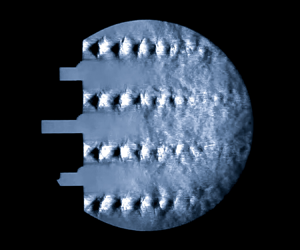Article contents
Scale dependence of local shearing motion in decaying turbulence generated by multiple-jet interaction
Published online by Cambridge University Press: 08 October 2024
Abstract

Scale dependence of local shearing motion is investigated experimentally in decaying homogeneous isotropic turbulence generated through multiple-jet interaction. The turbulent Reynolds number, based on the Taylor microscale, is between approximately 900 and 400. Velocity fields, measured using particle image velocimetry, are analysed through the triple decomposition of a low-pass filtered velocity gradient tensor, which quantifies the intensities of shear and rigid-body rotation at a given scale. These motions manifest predominantly as layer and tubular vortical structures, respectively. The scale dependence of the moments of velocity increments, associated with shear and rigid-body rotation, exhibits power-law behaviours. The scaling exponents for shear are in quantitative alignment with the anomalous scaling of the velocity structure functions, suggesting that velocity increments are influenced predominantly by shearing motion. In contrast, the exponents for rigid-body rotation are markedly smaller than those predicted by Kolmogorov scaling, reflecting the high intermittency of rigid-body rotation. The mean flow structure associated with shear at intermediate scales is investigated with conditional averages around locally intense shear regions in the filtered velocity field. The averaged flow field exhibits a shear layer structure with aspect ratio approximately 4.5, surrounded by rotating motion. The analysis at different scales reveals the existence of self-similar structures of shearing motion across various scales. The mean velocity jump across the shear layer increases with the layer thickness. This relationship is well predicted by Kolmogorov's second similarity hypothesis, which is useful in predicting the mean characteristics of shear layers across a wide range of scales.
JFM classification
Information
- Type
- JFM Papers
- Information
- Copyright
- © The Author(s), 2024. Published by Cambridge University Press
References
- 4
- Cited by


